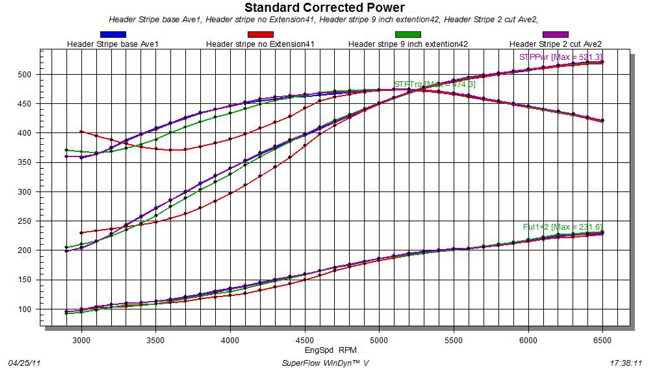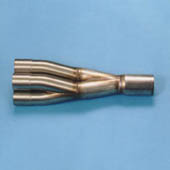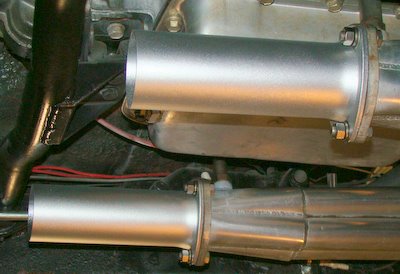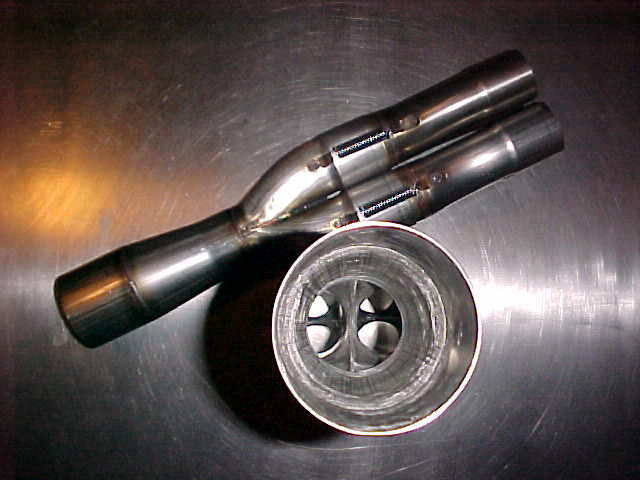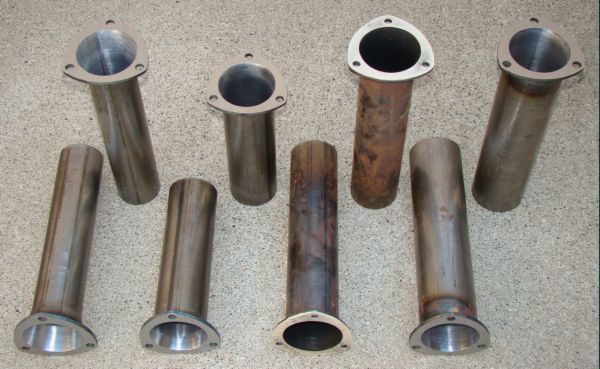Racing Technology
Pipe dreams
by Wayne Scraba
The art and science of tuning headers
"Adjustable headers? They're old news." It's true. Adjustable headers have been around drag racing for a long time. Trouble is, racers often leave the adjustable hardware in the box it comes in and run the sophisticated race car headers "as is." That might be the way to go with an unrefined, low-horsepower-per-cubic-inch application, but when you're trying to wring the last hundredth, or even tenth, of a second out of your combination, it's tough to beat a header that you can physically tune.
Knowledgeable racers have long been aware of the advantages of headers that can be tuned. There are several real-world uses for adjustable headers. They can be used to "fix" holes in the power curve, or they can be used to "move" the horsepower and torque peaks to a point where they are most advantageous. Just as important is that when track or atmospheric conditions change, the headers can be adjusted to compensate. A good example is when the track becomes greasy. By shortening the primary tubes or the collector, the bottom-end power can be reduced, and more usable power is added to the big end of the rpm range.
There are other situations in which these tuning aids can be used to make a car go quicker and faster down the quarter-mile. Horsepower is relatively cheap today, and it's very easy to come up with an over-powered and under-tired combination (this also happens to perfectly describe many "10-wide" fastest street car competitors, too). In simple terms, it's easy to find horsepower, but it might not be so easy to find traction, especially when you're dealing with non-tubbed, standard rear-suspension race cars.
Making them work
So what makes adjustable headers tick? Tunable headers allow you to add or subtract primary-tube length and add or subtract collector length. Further to this, the different collector configurations offered by header manufacturers provide another means of moving the horsepower and torque curves to suit your particular needs.
In tuning the headers for a given combination, many factors have to be taken into consideration, including vehicle weight, rear-axle ratio, transmission type, and the application. Experts advise that headers be tuned for the car rather than for the engine. Once the variables are taken into account, you can then determine at what rpm level the peak torque curve should be developed. Generally, the most important factor is the primary-tube diameter; however, primary-tube length can be used to move the torque curve in either direction, effectively moving the torque curve from one rpm level to another.
Hooker Headers points out that before you begin tuning, you have to understand that the main objective of an optimum exhaust system is to create a complete and total cleansing of the combustion chamber during the exhaust stroke. This "blow down" creates the ideal environment for the fresh air/fuel charge to be introduced into the chamber during the intake stroke. Powerplants that feature lengthy periods of valve overlap (the period of time in which the intake valves and exhaust valves are both open) can actually over-scavenge the combustion chamber, which in turn causes a portion of the unburned air/fuel charge to be exhausted.
As you can see from the preceding information, there is no perfect header size for every combination, especially when constantly changing track and atmospheric conditions are taken into account. That's why several header manufacturers offer adjustable kits.
Using Hooker's kit as an example, typically an adjustable kit will include a complete set of four-inch primary extensions and a complete set of six-inch extensions — eight each. To install or remove them, the slip-on collector is first removed. Each collector is held in place with a pair of bolts. Remove these and, with a small hammer and a punch, tap off the collector. The primary extensions simply slip into place over the primary pipes. Reinstall the collector and add the supplied tab extension to hold the collector in check.
When tuning your combination, you might find that a two-inch extension is all that's required, but no two-inch extensions are in the kit. Simply trim one set of the primary extensions to length. The various primary-extension lengths supplied will cover a range from about one-inch to six-inch increments.
Collection agency?
What does the collector do, and what size is best for your application? According to Hooker, the major function of the header collector is to take advantage of the "secondary tuning impulses" from the other pipes in the system. The influence of the collector is generally restricted to the engine rpm level below the powerplant torque peak. The sizing of collectors is more critical in powerplants that spend the majority of their time in the lower rpm ranges.
As an example, a typical high-performance small-block Chevrolet application will usually have a primary-tube diameter between 1 3/4 inches and 1 7/8 inches. The corresponding collector diameter will generally be between 3 and 3 1/2 inches. (Obviously, many Comp eliminator and Pro Stock Truck header primaries and collectors will be considerably larger — the above dimensions are for reference only.) In high-performance big-block applications, the header primary tube will range from 2 to 2 1/4 inches. The collector for this application will be between 3 1/2 and 4 inches. On the outer range of the spectrum, a 500-cubic-inch NHRA Pro Stock engine will use a primary tube of at least 2 3/8 inches with collector sizes of 5 inches.
Like other aspects of the adjustable header, several types of collectors are available. The standard 4-into-1 collector is a system most are familiar with. In this case, four collector stubs are arranged in parallel. Next, they join in a relatively long transition — roughly six to seven inches long, depending on the application — which reduces the overall diameter of the collector. Then the collector straightens for another four to six inches, ultimately ending.
Several aftermarket manufacturers offer a new-style "merged" collector for adjustable headers. Designed as an offshoot of the standard 4-into-1 system, they are available in all popular primary tube and collector sizes. These collectors are constructed with the primary tubes joining as they make the transition into the collector to form a spear. Eliminating sharp edges and voids reduces turbulence. In turn, the reduced turbulence provides for improved aerodynamic exhaust flow, but it also allows more precise management of the header sound-pressure waves. And that relates to collector tuning.
Both Hooker and Flowmaster offer another collector design that allows the pairing of cylinders based on firing order. Similar to the Tri-Y concept, the objective is to pair cylinders with the maximum separation in firing sequence. Generally, Tri-Y headers are used in applications in which the engine must operate over a wide and relatively low rpm range. Similarly, these split-flow collectors will make a noticeable difference in power characteristics in low- to mid-rpm ranges. When the powerplant is operated at high rpm, a conventional 4-into-1 collector will provide better performance.
Like other aspects of the header, there is no magical formula used to determine collector diameter. Instead, the race-header manufacturers note that it's back to the old-fashioned method of cutting and testing. By varying the length of the header collector, you can also adjust the basic power band of the powerplant. If your combination dictates more low-end torque, you should increase the header-collector length. If the combination "wants" less low-end torque, shorten the collector.
Determining collector length
That's a great concept, but how do you know what length is just right for your race car? It might prove easier than you might imagine, but first, be sure to establish the primary-tube length. Once that's done, draw a thick line down the length of the collector using a crayon or grease marking pen. Make a normal hard pass with the car and check out the crayon mark. The temperature of the exhaust gasses within the collector will usually cause the mark to discolor or burn at a specific location on each collector. You can shorten the collector at this point. Just be certain to leave an inch or two of added material for further fine-tuning. It's tough to add material to the collector once it has been cut.
If you find that your race car "needs" more collector, then simply add it with the extensions supplied in the adjustable header kit. How do you know if it needs more collector? Watch the crayon mark as well as your e.t. slip. If the crayon mark doesn't discolor or burn, then the collector is too short. In addition, if the car needs more bottom-end grunt and doesn't "leave" well, then you might be able to use more collector length.
As you can see, tuning headers isn't a cut-and-dry science. Instead, it's a game of test and try. Every car will require a slightly different header combination. Remember that weather and track conditions also determine the header primary and collector parameters. Pipe dreams? You'll never know until you add adjustable headers to your tuning repertoire.

